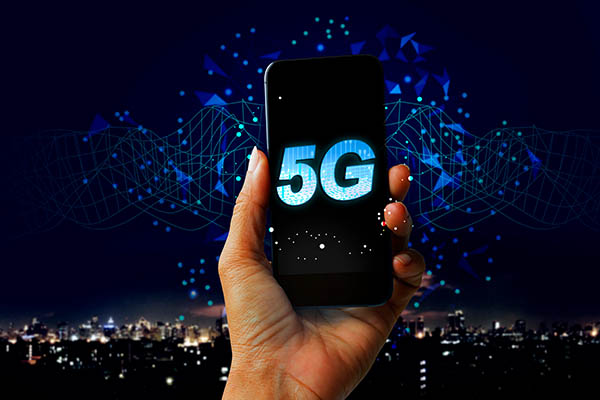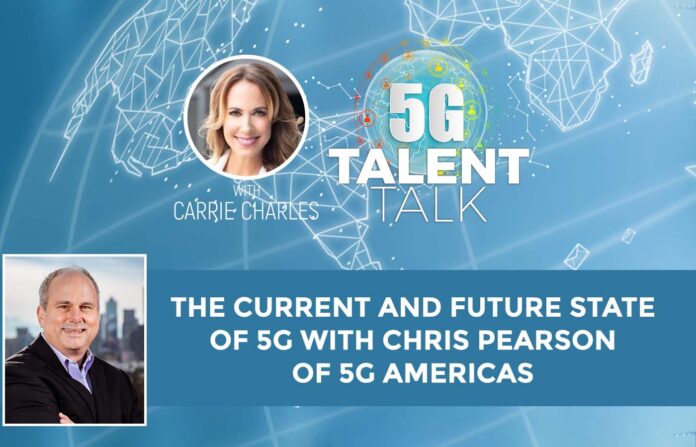5G is not merely a technology; it serves as the gateway to an unparalleled era of connectivity, efficiency, and innovation.
In this episode of 5G Talent Talk with Carrie Charles, we are joined by Chris Pearson, the President at 5G Americas. Chris highlights the world of 5G, the groundbreaking wireless network that is revolutionizing how we connect and communicate.
From the incredible speed and capacity it offers to the vast potential for innovation, 5G has taken the telecommunications industry by storm. Chris shares the highs and lows of 5G adoption and the current state of the wireless industry.
Chris recognizes that the Mid Band Spectrum is the key to unlocking 5G’s full potential – the sweet spot that caters to our hunger for both capacity and coverage. As he further explores the promising horizon of 5G, Chris draws parallels to a thrilling baseball game – we may only be in the fourth inning, but there’s so much more excitement to come.
The 5G-powered smart cities of tomorrow are equipped to redefine urban living, making life more efficient and seamless than ever before. Join us as we unlock the vault of 5G’s potential in shaping our future.
—
Watch the episode here
Listen to the podcast here
The Current and Future State of 5G With Chris Pearson of 5G Americas
I would like to introduce you to my special guest, Chris Pearson. He is the President of 5G Americas. Chris, thanks for joining me.
Thanks for having me. It’s a pleasure.
I want to hear about your story because you have been at the same organization for a long time. What led you to your seat?
What led me to my seat would be telecom was in my blood. My mom worked for Ma Bell when I was in high school and college. I saw that the telecom career has a lot of interesting technology and that at the time, we were starting to see the breakup of what was going to happen as far as the networks here in the United States. After college, I started at a wireline company but soon realized that wireless was the future.
One of my old bosses had moved to McCaw Cellular, which was one of the early national cellular providers in the United States. He reached out to me and my career started there and took off. Previously to this position, I was at 5G Americas, but we’ve been 4G Americas and 3G Americas. Previous to that, I led an organization similar to this, but it was for a different technology. This was back in the days of 2G and 3G.
How long have you been whether it was 3G, 4G, or 5G Americas? How many years?
I’ve been over twenty years. It’s been quite a career here. Seeing all the changes as we move from 3G to 4G to 5G, I’ve felt there are so many interesting things and so many areas for me to always keep improving, learning, and helping the industry.
Let’s get into it a little bit. Tell us more about 5G Americas. What does the organization do?
5G Americas is an industry association. We’re comprised of both operators and vendors in this 5G wireless ecosystem. They come together to collaborate and move the industry forward. We move the industry forward in three areas. We have three foundational areas that we work in. One, we do what’s called technical facilitation and coordination. We don’t write industry standards, but we are trying to explain them, contribute, and make sure that we can all work from the same page of the playbook to move forward.
A second area that we work in is regulatory policy and public affairs. That would be working with governments throughout the Americas region, North, Central, and South America, to make sure that the policies are allowing mobile wireless to continue and to progress. Finally, we do a lot of industry education. We work with industry media and industry analysts to make sure that they fully understand this great technology that we have, where we are, and where we’re going. It’s an industry association trying to progress mobile communications forward.
Where are we with the 5G rollout in the US? Can you talk a bit about some of the biggest challenges facing 5G?
We’ve made great progress around the world, in North America, and the US as far as 5G. I’ll start it with a big high-level global. There are 273 5G networks around the world. In North America, we have fourteen 5G networks. We’ve seen a great amount of progress as far as the deployments of 5G. As far as the US, we are one of the leaders in 5G as far as deployments, connections, and so forth. If you look at the US, we’re covering over 325 million potential customers in the United States. We’re making great progress. Globally, we’re at 1.2 billion 5G connections, and we expect by the end of 2023, that’s going to end up being 1.9 billion. As far as 5G globally and even 5G in the United States, we’re making great progress. It’s a great story.
Has there been anything that has impacted that rollout specifically in the past 6 to 9 months?
Getting back to your question, there have been challenges. There are challenges when you bring new technology to the marketplace, but what are the things for our industry or mobile communications? Some of the challenges are things like cell siting regulations and trying to streamline those cell site regulations. When you look at 5G or cellular technologies, to get the capacity or the coverage, you need more cell sites and more density. We are always trying to hopefully get more streamlined regulations and allow us to build more cell sites and provide even improved customer service.
Another challenge that we’ve had is called Spectrum. Radio spectrum, for all your readers, is the fuel for our industry. It’s our lifeblood. It allows us to provide the capacity in an efficient way to customers. Spectrum has been a challenge in the United States. We need more spectrum. The sweet spot of the spectrum for 5G is something called Mid-Band Spectrum. That gives us both the capacity and the coverage that we need. There is the challenge of that, and we’re hoping that the US government can move forward with a national spectrum pipeline plan and get us to where we need to be as far as more Mid-Band Spectrum coming online.

What are your thoughts on the state of the wireless industry? We’ve seen a slowdown. Will it bounce back in ‘23 or ‘24? What do you think?
There have been some ups and downs when people look at 5G. There are skeptics out there who have said, “You over-promised a bit,” or things like that. I’m quite positive about the industry. When you look at the technological innovation that came with 5G as far as what 5G can enable for the future, it takes time. It takes a while. We’ve done a great job of technical network rollouts. Everything’s a challenge.
When you look at where we want to be, we’re not quite there yet. It’s baseball season here, and if it was a nine-inning baseball game, we’re probably in about the fourth inning of that baseball game. We’ve done the network deployments. We’ve gotten quite a bit of spectrum out into the market, although we need more. It takes a while to get to what would be considered the solutions basis, and the solutions are the new use cases that we want to address in the future. Overall, I’m positive about 5G, what it’s done, and where it’s going. I do think there’s a lot more to the story in the next 2 or 3 years.
It seems like we need to have some patience.
As we mentioned in the early part of this interview, I’ve been in the industry for a long time. I remember when we were in the 2G and 3G story and we were talking about download rates in 2G of 28 kilobits per second. On 3G, we were higher than that. We’ve gone from many years ago doing 100 kilobits per second to now doing 100 megabits per second. There are a lot of positive stories. They don’t always get reported about how well our industry has performed. Overall, there are a lot of great things that can happen in the future.
Let’s talk about some of those great things. Share some 5G use cases. What vertical markets would benefit the most?
There are going to be many that have the potential to be great use cases. Out of the gate, one of the use cases that’s been important to the industry and the customers has been the idea of how we consume data and the fact that fixed wireless access has been a big use case for 5G at this point. What that does is give an alternate way or an additional competitive player for providing your home or business mobile broadband service. We’re seeing that is one of the use cases that’s been quite popular and taken off.

Another one that comes to mind is to look at the manufacturing. The manufacturing area is at the tip of its iceberg where factories are starting to understand that they don’t need as many cables. They don’t necessarily need as much as far as other types of communication. They can all do it with mobile wireless. Mobile wireless will be a private enterprise network for their solution at their factory and beyond. Those are a couple, but there are others that I don’t want to get into all of them but things like how our cities operate are going to be changing in the next five years. There are going to be many more things done efficiently in our cities. They are going to be smart cities where everything’s connected and much more seamless as far as operations.
I want to get into that a little bit more because you’ve mentioned private 5G networks as well as 5G for fixed wireless access. Can you explain the advantages of using 5G for fixed wireless access compared to traditional wired broadband solutions? Can you expand on that?
There are a lot of different areas. For fixed wireless access to your home, what we’re seeing from the third-party studies that have been done is people are choosing it because 1) It’s an additional competitive player in the marketplace and provides good broadband speeds to them. 2) It is usually at a good value point for the home competitive market for mobile broadband versus fixed broadband. 3) There are a lot of places that still aren’t able to get the broadband coverage that they need on a wired basis. Fixed wireless provides the ability to get to that customer that doesn’t have it before. That would be more of a home-type of atmosphere.
From a private enterprise network side, there are things where that would be more of a solutions system. When you look at what it can do as far as a private enterprise using 5G, you have a bit more control of your network because you are in control of the spectrum and everything that’s happening in your private enterprise. Also, because of that control, you might have improved connective connectivity and reliability because you have your dedicated spectrum for the private enterprise network. Even things like increased security and data privacy can be increased because of your control of that network being a private enterprise mobile wireless network.

We talked a lot about spectrum so far, but I want to get a little deeper here and talk about specific spectrum challenges that are facing the US in the context of 5G deployment and how it’s impacting the rollout of the technology. Dig in a little further because this has been a major challenge and will continue to be.
Spectrum is one of the key ingredients for 5G mobile communications as it was for 4G. In the US particularly, we’ve had a few challenges. One of them is what’s called the FCC, Federal Communications Commission. They always had, for as long as I’ve been in this industry, which is a long time, what’s called auction authority. That is the ability to identify and allocate an auction spectrum and even assign it after it’s been paid. Now, our Congress has allowed that auction authority at the FCC to expire.
Our industry is in a holding pattern with the FCC as far as what they can do with a spectrum that they’ve already been told that they should be assigning and auctioning. That’s a real key impediment to the future. I am hopeful that our Congress will realize the importance of the FCC having the auction authority. They’ve had it for as long as I can remember. I’m hopeful that very soon, the FCC will get that back.
Another area of major concern in the United States is this idea of the NTIA, which manages the Federal spectrum portfolio. It needs to continue to work hard as they’re doing to come up with a national spectrum plan. That national spectrum plan would be the future planning or roadmap of spectrum for the United States as far as which specific bands are going to be identified, cleared, and then auctioned and managed by the FCC at a later date. There are a couple of pieces here that are challenging. I am hopeful that soon both the FCC Auction Authority will be reinstated by Congress, and I’m hopeful that soon, NTIA will have a national spectrum plan.
This question may go hand in hand with the last. Can you talk more about the role of government policies and regulations in fostering 5G innovation as well as investment in the US?
We’re seeing quite a bit of positive things that are happening through governments, specifically in the United States. We have a program to try to connect broadband to all Americans. It’s called the BEAD Program, which is a lot of funding to connect America. About $42 billion is assigned to that program. What we want on that program, as an example, would be to make sure that mobile wireless and fixed wireless have an opportunity to compete and show what we can do. We think fiber is a great technology, but also, we do understand that fixed wireless should play a role in that.
Governments need to find ways to encourage investment and encourage the opportunity for mobile wireless for trusted entities to participate. They need to look at the various areas, and specifically mobile wireless, how important we are to jobs and the economy. When it comes to mobile wireless as an example, streamlining cell site processes is key to us trying to make sure that we can build our networks the way we need to be competitive, not just in the US but competitive on a worldwide basis as far as technology. Being able to have more radio spectrum is critical. A roadmap for spectrum in the future is key to us to make sure that we can compete not just in the United States, but compete on the world stage for technology and innovation.
Streamlining cell site processes is key to building our networks the way we need to be competitive.
Also, when looking at government programs that have a real impact on Americans and what their mobile broadband or broadband capabilities are, make sure that mobile wireless communications or cellular wireless is one of the areas of solutions that are available to the states as well as the customers in programs that are funded from the US federal budget. There are lots of areas that are important to mobile wireless that the government is participating in and can help us to make sure that we continue to be not only a mobile wireless leader in the world but also a technology leader in the world.
I’m getting inspired so far. Lots of positivity, and I love that.
We need more inspired people throughout the world.
How would you say that 5G networks contribute to sustainable development and also to environmental conservation efforts?
5G is a more efficient technology than our previous technologies, 4G, 3G, and 2G. It utilizes less power than what we’ve built as far as our previous network. That’s critical to all of us who understand this technology and want to make sure that our planet is preserved for ecological reasons. Also, if you look at how people are more efficient in their personal and business lives, it’s not stated enough how we live our lives because of our smartphones and because we’re always connected. The efficiencies that we get in those areas are underrated and underreported.
We’re more efficient in our lives, and because we’re more efficient, we use less energy in many parts of our lives. The fact that 5G uses less energy, we also are continuing to develop in our standard new ways to save energy for the future. Part of that as an equation that doesn’t get reported enough or needs to be studied more is that we’re more efficient in our lives.
One topic that’s on everybody’s mind with 5G is security. What are unique security challenges with 5G networks and how are they being addressed?
5G is the most secure mobile network that we’ve ever developed. It’s more secure than 1G 2G, 3G, and 4G. The challenges that we address start with what would be considered our standards processes at 3GPP, which does the standards for 5G, as well as our best practices that come throughout our industry. That would be the first thing. The second that we work hard on is what’s called enhanced encryption and enhanced authentication. These are two areas that we all know bad entities are always trying to get to us on and we continue to develop enhanced encryption and thought authentication.
Also, as an industry, this has happened specifically during COVID-19, even what was already starting to float to the top would be looking at the supply chain, understanding the supply chain risks, and making sure that we have what’s called trusted entities that are providing our communication services and capabilities as far as equipment goes in our network.
The US government has been working hard with our industry to make sure that we have a supply chain that has trusted entities. Finally, in areas like 5G Americas where we do security papers, GSM Association and other key associations around the world and look at collaboration and information sharing about security, what your risk might be, and how we can make sure that we are staying with safe and successful mobile communications networks and one step ahead of the bad entities.
There are challenges. There’s more threat to 5G than ever before because we are connecting more devices in new and better ways than ever before. The threat is larger as we connect more devices, but at the same time, our standards, our best practices, and our technological capabilities improve to make our network secure.
There’s more threat to 5G than ever before because we are connecting more devices in new and better ways than ever before.
Chris, some analysts talk about whether or not 5G rollouts have been worth it. What do you say to that?
There are a lot of skeptics in the world. I’m laughing because, at any time when you consider taking a leap in technology as we’ve done from 4G to 5G, it takes time to move from not just putting out networks and putting a smartphone in your device, which would be considered more of a transactional process to more of a solutions process. There are some skeptics out there in the marketplace, but we’re in the fourth inning of a nine-inning baseball game. If we’re in a football game, we’re only in the second quarter of a four-quarter game. There’s a lot to be done with 5G, and we’re going to get there.
I also like to point out that 5G is the fastest-growing mobile technology in the history of mobile communications. We have grown faster than 1G 2G, 3G, or 4G. Also, by the end of 2023 worldwide, on a smartphone, your global usage or mobile usage data will be 20 gigabits per month for an average user. People who have 5G are using 5G more than ever. Our networks are being deployed. We’re in the fourth inning of a nine-inning baseball game. Was it worth it? Absolutely. We are in the era of technology innovation, and this technology innovation has begun.
5G is the fastest-growing mobile technology in the history of mobile communications.
I know we’re in the fourth inning, but we all want to know what’s next. I have to ask you about 6G. How will advances in 6G impact this 5G story? Is it going to be like past Gs? Get out your crystal ball.
If I had a crystal ball for thinking about 6G or IMT-2030 as ITU is going to call it, it’s a little bit too early to know exactly what it’s going to do and how it’s going to do it. There’s been a lot of academic research. We have a lot of companies, and 5G Americas are doing research on it as well. We’ve written papers on it as well as other associations. We all know that at some point, it will be defined by what it can do and how it can do it. It’s hard to know how it will change things.
My expectation from some of the research papers is it will look to access more spectrum capabilities. It will have improved coverage areas and more interoperability with other technologies. If I had the crystal ball to know exactly what it is at this time, that would be great. Reading the different research papers, we’re still early in the process. What I would say is this. 5G will provide a foundation for 6G. In all the papers that I’ve read about 6G or what it could be because we know what it’s going to be yet, what I see is a lot of what 5G is building now will be in 6G.
It’s early on 6G. It’s being talked about. It is a new buzzword and we’re starting to see things shape, but there’s been no standards developed yet on it. We’re at the tip of the iceberg of what it could be. You’ll see improvement from what 5G can do. 5G is building that foundation for what probably will be 6G, and 5G is going to be showing us the way for that.
Chris, this has been wonderful. I’ve learned a lot. Where can we learn more about 5G Americas?
We can learn more at 5GAmericas.org. There are a great amount of white papers, press releases on the technology, and other presentations that you can find. There is a lot of information there, and it would be great if your readers could look at our website and learn more about our industry.
I know I will. Chris, thanks so much for coming to the show.
Thanks for having me and have a great week.
You take care.
Thank you.
Important Link
About Chris Pearson
 Chris Pearson is the President of 5G Americas. In his executive role, he is responsible for the overall planning of the organization and providing management for the integration of strategy and operations in the areas of technology, marketing, public relations and regulatory affairs. As President of 5G Americas (formerly called 4G Americas), Mr. Pearson represents the organization’s Market Representation interests within the 3rd Generation Partnership Program (3GPP) organization.
Chris Pearson is the President of 5G Americas. In his executive role, he is responsible for the overall planning of the organization and providing management for the integration of strategy and operations in the areas of technology, marketing, public relations and regulatory affairs. As President of 5G Americas (formerly called 4G Americas), Mr. Pearson represents the organization’s Market Representation interests within the 3rd Generation Partnership Program (3GPP) organization.
Mr. Pearson led the organization from its inception in 2001 as the 3GPP family of technologies market share grew from 10 percent in 2001 to more than 90 percent in North, Central and South America. Mr. Pearson came to the organization from the Universal Wireless Communications Consortium (UWCC) where he served as Executive Vice President in charge of the strategic executive management of the global TDMA wireless technology consortium. Prior to joining the UWCC, Mr. Pearson held several senior technical and marketing positions at AT&T Wireless and GTE.
With more than 28 years of experience in the telecommunications industry, Mr. Pearson is a recognized spokesperson in mobile wireless and 5G technology trends and has spoken at technology conferences throughout the world including CES, Mobile World Congress, CTIA, LTE World, 5G World North America, and 5G Forum USA.
Mr. Pearson earned a Master of Business Administration degree from The Albers School of Business and Economics at Seattle University and a Bachelor of Arts degree with emphasis in Marketing and Finance from the University of Washington.
Love the show? Subscribe, rate, review, and share!
Join the 5G Talent Talk Community today:

